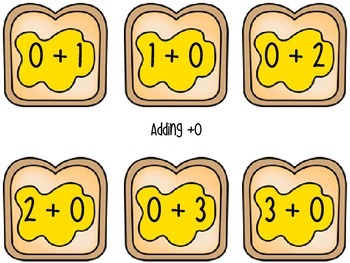Addition Center (Flipping Toast)
Jennifer Wilson
34 Followers
Grade Levels
PreK - 2nd, Homeschool
Subjects
Resource Type
Standards
CCSS1.NBT.C.4
CCSS1.OA.B.3
CCSS1.OA.C.6
CCSS1.OA.D.8
Formats Included
- PDF
Jennifer Wilson
34 Followers
Description
This addition math workstation included equations for the following skills:
-Adding Zero
-Adding One
-Doubles
-Doubles Plus 1
-Combinations of 5 and 10
***JUST ADDED: 10 + _ ***
This will be a growing math resource. I will continue to add throughout the school year.
FLIPPING TOAST: SUBTRACTION COMING SOON!
-Adding Zero
-Adding One
-Doubles
-Doubles Plus 1
-Combinations of 5 and 10
***JUST ADDED: 10 + _ ***
This will be a growing math resource. I will continue to add throughout the school year.
FLIPPING TOAST: SUBTRACTION COMING SOON!
Total Pages
Answer Key
N/A
Teaching Duration
N/A
Last updated Aug 26th, 2015
Report this resource to TPT
Reported resources will be reviewed by our team. Report this resource to let us know if this resource violates TPT’s content guidelines.
Standards
to see state-specific standards (only available in the US).
CCSS1.NBT.C.4
Add within 100, including adding a two-digit number and a one-digit number, and adding a two-digit number and a multiple of 10, using concrete models or drawings and strategies based on place value, properties of operations, and/or the relationship between addition and subtraction; relate the strategy to a written method and explain the reasoning used. Understand that in adding two-digit numbers, one adds tens and tens, ones and ones; and sometimes it is necessary to compose a ten.
CCSS1.OA.B.3
Apply properties of operations as strategies to add and subtract. If 8 + 3 = 11 is known, then 3 + 8 = 11 is also known. (Commutative property of addition.) To add 2 + 6 + 4, the second two numbers can be added to make a ten, so 2 + 6 + 4 = 2 + 10 = 12. (Associative property of addition.)
CCSS1.OA.C.6
Add and subtract within 20, demonstrating fluency for addition and subtraction within 10. Use strategies such as counting on; making ten (e.g., 8 + 6 = 8 + 2 + 4 = 10 + 4 = 14); decomposing a number leading to a ten (e.g., 13 - 4 = 13 - 3 - 1 = 10 - 1 = 9); using the relationship between addition and subtraction (e.g., knowing that 8 + 4 = 12, one knows 12 - 8 = 4); and creating equivalent but easier or known sums (e.g., adding 6 + 7 by creating the known equivalent 6 + 6 + 1 = 12 + 1 = 13).
CCSS1.OA.D.8
Determine the unknown whole number in an addition or subtraction equation relating three whole numbers. For example, determine the unknown number that makes the equation true in each of the equations 8 + ? = 11, 5 = ▯ - 3, 6 + 6 = ▯.





